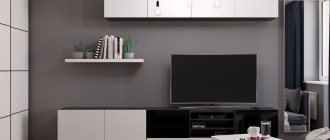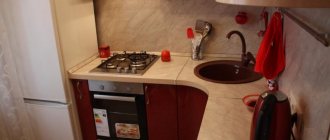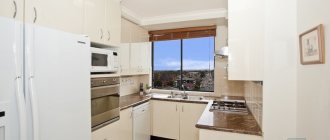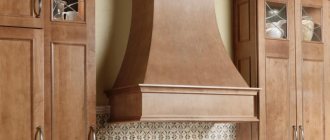95915
The kitchen is an important element of home improvement. It carries an important functional load. This is where food is prepared, the process of procurement and preservation takes place. Most often, it also houses a dining area for daily meals. Therefore, a smartly planned space greatly optimizes all processes. This is especially true for small kitchens. The kitchen furniture set is the main forming element of this system. A corner cabinet for a kitchen sink, which will be discussed later, will help you rationally distribute your work space.
Design Features
Before considering the main types of corner kitchen cabinets, we will determine for what purpose the corner segment serves and what functions it performs.
The meaning and functional loads of a corner sink cabinet:
- connecting - that is, thanks to this segment, the furniture set transitions from one wall to another;
- technical - it contains one of the important components, namely the sink and communications to it. This main purpose is to rationalize the space used. A corner sink is convenient because it can be equidistant from the work table and the hob. This goes a long way towards making cooking convenient. In addition, it can accommodate sinks of different configurations and sizes. Inside it, in addition to the communications drainage system, there may be water filters, a flow-through heater, garbage containers, retractable storage systems, most often household chemicals;
- aesthetic function - this element fits organically into the overall space.
Accessories for corner sinks
In a plumbing store, when purchasing a corner sink, they can offer a complete set of various useful accessories for everyday life. These can be containers for brushes, soap dishes, drying nets, crossbars for cleaning fruits and vegetables, various containers for storing useful kitchen items. All these items will find their place on the corner sink, and most importantly, they will make the life of every housewife somewhat easier.
The effectiveness of a double sink is obvious: you can wash food and soak dirty dishes in it at the same time.
Varieties
There are two types of corner kitchen sinks: L-shaped with an acute angle, these sections are also called attached, and a kitchen cabinet with a beveled corner. They differ in internal overall dimensions, design, quantity and method of opening the doors, and ease of use.
Corner cabinet for the kitchen under the sink, main overall dimensions.
| Type of corner segment for sink | Corner cabinets for kitchen sink dimensions |
| L-shaped bedside table with an acute angle, attached |
|
| Kitchen cabinets with beveled corners. Equilateral dimensions (adjacent to the wall) - from 85 cm to 90 cm. The height of all types of segments varies from 85 cm to 90 cm. For ease of cleaning, the segments are equipped with legs (up to 10 cm), which can be covered with a furniture strip. It is attached to special clips. |
|
Custom-made kitchens may have slightly different overall dimensions.
L-shaped
With beveled corners
Shapes of corner sinks for the kitchen
Round corner sink . Every housewife spends a lot of time in the kitchen, preparing food and doing other household chores. An impractical corner sink will make being in the kitchen a real challenge. To avoid this, you need to choose the most suitable option for a corner sink for the kitchen.
Round sinks have gained popularity relatively recently. Such models are purchased no less often than rectangular and square products. In terms of space, a round sink has increased capacity and therefore has a larger volume.
The round sink fits perfectly into the corner of any kitchen.
The round corner sink has a fairly compact size, so it is ideal for owners of small kitchens. The distinctive features of this model are a wide range of choices, functionality and visual appeal.
The advantages of a round-shaped sink: it is spacious, due to the absence of corners in it, the hygiene of the product increases, and its compact size allows you to save space in the kitchen. At the same time, the design of such a sink looks very original.
Square corner sink . This form of sink is functional, even when used in a small kitchen, with standard countertop dimensions. The square corner sink is spacious.
A similar sink with a side wing will fit perfectly into the interior of a small kitchen.
Sinks of this type are most often made with one bowl, without additional functional components. Corner square sinks are quite in demand, although they are somewhat inferior in popularity to rectangular designs. In addition to convenience and functionality, the square-shaped sink is distinguished by its versatility.
It can even be placed on a countertop of non-standard depth, which opens up wide possibilities for equipping the work surface with some additional elements: wings, bowls, boards and other kitchen accessories.
Selecting size and shape
In order to make the right choice of corner cabinets, you need to know their features, advantages and disadvantages. In attached sections with an acute angle, the internal space is smaller than that of the second type of cabinets. They can be equipped with two doors or one that opens two sections at once (accordion door). The convenience of the second option is that access to the far corner inside the section is simplified. A corner cabinet for a kitchen sink with a beveled corner is more spacious, as it has a larger volume. It is possible to install a larger sink. In addition, they are convenient in terms of use, since the beveled corner makes it easier to access the sink. The disadvantage is that it only has one small door.
The problem area of corner sections under the sink is the countertop. The standard canvas has a width of 60 cm. In the case when postforming, a laminated tabletop is used, there is a seam on the corner segments. This point is not relevant for cast countertops made of artificial stone. Corner overhead sinks are sold that fully correspond to the dimensions of the working surface of the cabinet. Or, for this section, purchase a special postforming with a width of 120 cm.
What else needs to be taken into account when choosing a corner segment:
- kitchen area. A section with a beveled corner takes up more space;
- You should immediately decide on the size and shape of the kitchen sink.
You don’t have to purchase it right away, but you need to select a model and download the technical drawing on the Internet. When you purchase a cabinet, take it with you and show the sales consultant the drawing. This will help avoid possible mistakes;
- material used to make kitchen and countertops. Remember that laminated boards are most prone to swelling from moisture. Therefore, it is desirable that the surface of the tabletop be seamless;
- general style and interior design;
- decide whether additional elements will be located in the corner element: chopper, filters, flow-through heater. In this case, it is reasonable to give preference to a segment with a beveled corner.
Only by summing up all these points can you make your choice.
Advantages and disadvantages of a corner kitchen sink
This option for arranging a kitchen is most often used when using an L-shaped layout, which allows you to create the most comfortable space in the kitchen.
The corner sink is the most popular option in the kitchen.
Advantages of this solution:
- There is a significant saving of space in the kitchen, thanks to which you can equip a larger countertop, as well as equip several additional places for storing kitchen utensils.
- Thanks to the huge range of similar designs, which are available in different sizes, shapes and colors, you can fit a corner sink into any interior.
- A kitchen with a corner sink always provides more comfortable conditions for the housewife, as she has to move around the room less - all the most important work areas are located close to each other.
- Under the corner sink, more free space is created, which is perfect for installing a trash can, as well as for storing household chemicals, large dishes and other kitchen utensils that take up a lot of space.
However, there are some disadvantages of a corner sink:
- If you install a sink that is too large, the corner located directly behind it can become a so-called “dead zone”. However, such a place is perfect for placing various kitchen items that should always be at hand.
- If plumbing repairs are required, it will not be very convenient to carry out it, since the door of the corner cabinet located under the sink is always much smaller than the space that is hidden behind it.
When installing a corner sink in the kitchen, it is important to take into account all the nuances of this solution, because sometimes even replacing water filters, which will have to be done regularly, can become a real problem.
Advice! To install the ideal sink in the kitchen, providing maximum convenience to the household, you should evaluate different options for designs, shapes, sizes and materials.
Manufacturing materials
When deciding on a cabinet, you need to navigate the materials from which it is made. Main types of materials:
- laminated board is an affordable option. This is essentially compressed glued wood chips covered with a layer of plastic. Please note that moisture must not get inside the slab. For these purposes, the ends, in the part where water can get in, are protected with an edge;
- cabinets made of laminated board with MDF facades. MDF is wood waste crushed to a dispersed state, vacuum-pressed under high pressure. On top, the slab is covered either with a thin layer of a special film, or with veneer (a thin cut of wood), veneered facades. The slab can be protected by painting. Painted MDF has a wide range of colors. Another advantage is that they can be embossed. The façade does not require edge finishing at the ends. The most popular and optimal option in terms of price and quality;
- natural wood - in the vast majority of cases, only facades are made from it. Wood, although the most environmentally friendly material, is also quite capricious. It must be well dried, expertly fitted and coated with special varnishes. These compounds protect it from moisture, temperature changes, and mechanical stress;
- facades made of plastic and glass - they are quite beautiful and expressive. But expensive, like wooden ones. They are framed with aluminum end tape. Susceptible to scratches, glass, chips and cracks;
- cabinets made of food grade metals. This is most often furniture for food production, where increased sanitary and hygienic requirements are imposed.
The sink plays an important role for ease of use.
Wooden
Chipboard
MDF
How to choose the right size corner sink
The dimensions, namely the volumes of bowls for corner sinks, can be very different. Even the smallest sink can have significant depth, just as a large sink can be quite shallow.
When choosing a corner sink of a certain size, you should take into account some parameters: how large the dimensions of the kitchen furniture are, what size dishes household members most often use, and also what is the height of the countertop.
The depth of the sink should be such that when the water is turned on it does not splash out. And also that at least one set of kitchen utensils fits in it.
If the height of kitchen cabinets is about 85 cm, you should not choose bowls that are too deep (more than 20 cm). There is no need for deep sinks even if the kitchen has a dishwasher. The universal bowl size for all types of sinks (including corner ones) is a depth of 16 to 20 cm. This volume is quite enough to avoid splashing water; this depth is convenient for washing pots, pans and plates.
Using examples from the video, you can see what options there may be for rational placement of the sink and accessories.
Options for corner segments
There is a wide range of sinks on the market, including corner sinks.
What types can be used:
- corner sinks - for cabinets with a sharp corner, rectangular sinks are suitable. For the second type, with a beveled corner, the choice is wider, since the working surface is larger;
- round sinks 50, 60 cm, these are standard sizes. It should be remembered that a section with a sharp internal corner is also suitable for sink 50;
- direct sink - most often manufacturers produce them in lengths of 60 cm (600 mm) and 80 cm (800 mm). The depth depends on the type of sink (countertop or mortise) and shape.
A floor-mounted corner cabinet for a sink, its choice, is directly related to the size and shape of the sink.
Round
Oval
Rectangular
Corner
Kitchen corner sink color
As for the color scheme of the corner sink, it should depend on the chosen style of the kitchen interior. Currently, the most popular sinks are white, as well as metallic-colored products (as a rule, they are made of stainless steel).
A wide selection of colors is preferable for sinks made of artificial stone.
Models made in black and gray tones, made of synthetic stone, are becoming increasingly popular. If desired, you can choose any color for the sink - the main thing is to harmoniously fit such a product into the kitchen design.
A corner sink is great for small kitchen spaces.
Filling
Don't forget to take into account the interior contents of the cabinet. If technical components are concentrated there (chopper, water filter, flow-through heater), then it is wise to use a cabinet with a beveled corner, since it is more spacious. When you plan to use it for storage, both options are suitable. You just need to decide on the dimensions of the stored items. The height of the shelves will depend on this.
In an attached segment with an acute angle, it is possible to use special pull-out baskets and rotating shelves, this is quite convenient.
If a garbage container is located in the corner segment, then when planning the interior space, it is better to know its size in advance. Then you can rationally place additional shelves.
Tips for choosing
When deciding what the corner floor element for the sink will be, take into account the totality of the above factors. The best material for countertops is artificial stone. Then a sink made of the same material would be more suitable. If the work surface is covered with a countertop made of laminated slabs, then it is more correct to use overhead sinks.
A segment made entirely of laminated board is not much cheaper than a cabinet with an MDF facade. Therefore, from an aesthetic and practical point of view, preference should be given to the second option.
The main thing for the safety of the cabinet is maximum protection from water getting inside the stove. To do this, all possible joints are sealed with sealant, edges in contact with moisture are trimmed with protective tape, and furniture plinths are installed.
How to make it yourself
If you have certain skills, you can assemble the corner segment yourself. A laminated board is the best option for a do-it-yourself kitchen and is the easiest way to make one.
The sequence of actions is as follows:
- decide on the type of section. To do this, consider the size of the room and what will be located inside the segment;
- Check out the main types of sinks for corner cabinets. Both types are suitable for sink 50. Choose the best option and download the sink drawing;
- think over and sketch a drawing of the cabinet with detailed dimensions;
- With a drawing, contact a company that cuts laminated boards to size. They will also tell you where to buy components and end tape;
- When all the blanks are available, you can assemble the corner segment. To begin with, install the sidewalls and attach them to the bottom of the cabinet. Next, the connecting strips are installed and secured. Then the legs are screwed on. Mark and cut out recesses for door fastenings. They install them and hang the doors. Depending on the type of sink, overhead or mortise, prepare the countertop in order to mount the sink. To make a hole in the tabletop, use a jigsaw. First make markings on the countertop according to the shape of the sink. A mortise sink is installed only with sealant. It is important to follow the assembly sequence.
So, the floor corner segment for the sink is an important element of the kitchen furniture set. It carries a significant functional load. There are two main types of cabinets. Depending on a number of the above facts, they choose one of them. A significant element is the shape and size of the sink and internal filling. When choosing a material, the interior design plays a major role.











